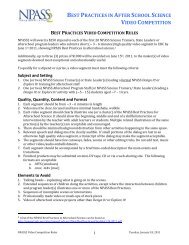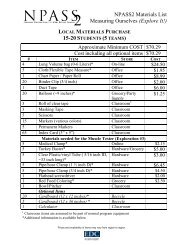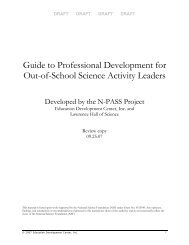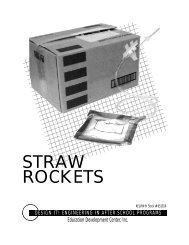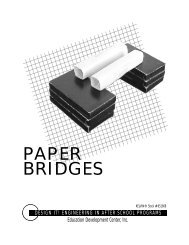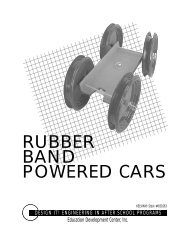EDC Sinking/Floating - NPASS2
EDC Sinking/Floating - NPASS2
EDC Sinking/Floating - NPASS2
Create successful ePaper yourself
Turn your PDF publications into a flip-book with our unique Google optimized e-Paper software.
Explore It!<br />
SCIENCE INVESTIGATIONS<br />
IN OUT-OF-SCHOOL PROGRAMS<br />
<strong>Sinking</strong> & <strong>Floating</strong>
<strong>Sinking</strong> & <strong>Floating</strong><br />
How to Use This Guide..........................................................................................ix<br />
Overview................................................................................................................xi<br />
Exploration 1: What Floats and What Sinks? ........................................................1<br />
Exploration 2: Making <strong>Floating</strong> Things Sink ......................................................11<br />
Exploration 3: Design a Boat: Making <strong>Sinking</strong> Things Float ..............................19<br />
Exploration 4: More About Boats ........................................................................29<br />
Exploration 5: <strong>Sinking</strong> and <strong>Floating</strong> Liquids (optional) ......................................41<br />
Exploration 6: Cartesian Divers............................................................................51<br />
Appendix<br />
Materials Shopping List..................................................................................63<br />
Station Explorations: Buoyancy ....................................................................67<br />
Additional Resources......................................................................................75<br />
Letter to Families ............................................................................................77<br />
Explore It!<br />
vii
WHAT FLOATS AND WHAT SINKS?<br />
EXPLORATION 1<br />
In this exploration, your team will investigate whether certain familiar objects sink or<br />
float in water. First, you will make predictions about which items will sink or float, and<br />
then you will test to see whether your predictions were correct.<br />
WHAT TO DO<br />
PART 1<br />
Predicting<br />
1. Look at the objects your program leader has given you. For each one, predict whether<br />
it will sink or float in water.<br />
2. On the Will It Float or Sink? chart provided, give your prediction and write the<br />
reason you think your prediction is correct.<br />
PART 2<br />
Discovery Question<br />
Of the items you have been given,<br />
can you predict which will sink and which will float?<br />
Testing<br />
1. Fill the paint bucket about half full of water.<br />
2. Place each item in the water to see whether it sinks or floats.<br />
3. Fill in the result in the last column of the Will It Float or Sink? chart.<br />
WHAT TO THINK ABOUT<br />
• What properties of the object may cause it to sink or float?<br />
• For those objects that floated, what were they made of? What was their shape?<br />
• For those objects that sunk, what were they made of? What was their shape?<br />
• Were there other properties that the two groups of objects had in common? Were<br />
there other properties that were very different?<br />
1<br />
EXPLORERS’ SHEET<br />
1<br />
GUIDING THE EXPLORATION<br />
1<br />
BACKGROUND<br />
Explore It!<br />
1
WHAT FLOATS AND WHAT SINKS?<br />
EXPLORATION 1<br />
1<br />
EXPLORERS’ SHEET<br />
WILL IT FLOAT OR SINK?<br />
For each object you look at, predict whether it will sink or float in water in the third column.<br />
Then write the reason for your prediction in the next box. Finally, test each object to see<br />
whether it sinks or floats, and write that result in the final box.<br />
Object<br />
Type<br />
of<br />
Material<br />
Prediction:<br />
Sink or<br />
Float?<br />
Reason(s)<br />
for Your<br />
Prediction<br />
Actual:<br />
Sink or<br />
Float?<br />
1<br />
GUIDING THE EXPLORATION<br />
1<br />
BACKGROUND<br />
2 <strong>EDC</strong>’s Center for Science Education
WHAT FLOATS AND WHAT SINKS?<br />
EXPLORATION 1<br />
MATERIALS<br />
For Each Team<br />
• 1 paint bucket*, partially filled with water<br />
• 1 “Sink-and-Float” collection, which may contain some or all<br />
the following (you may also use alternative items):<br />
- apple<br />
- potato<br />
- metal paper clip<br />
- modeling clay (oil based)<br />
- plastic spoon<br />
- Styrofoam meat tray<br />
- Styrofoam cup<br />
- cork (available in hardware stores;<br />
you can also use corks from wine bottles)<br />
- piece of a half-gallon milk carton*,<br />
cut into squares 4 inches x 4 inches<br />
- drinking straw<br />
- empty can<br />
- piece of 2-liter soda bottle, cut into squares or strips<br />
- ice cubes<br />
- string<br />
- wooden ball<br />
- glass marble<br />
- plastic bead<br />
- high-bounce ball 1<br />
• 1 Explorers’ Sheet, including the Will It Float or Sink? chart<br />
Shared<br />
• newspaper or sponges (for cleanup)<br />
For the Program Leader<br />
• 1 GladWare Mini Round container with lid*<br />
(alternative: 1 35-mm plastic film canister with lid)<br />
• modeling clay (2 ounces or a 2-inch cube)<br />
• 1 apple (or similar fruit or vegetable that floats)<br />
• 1 large bucket (3–5-gallon size)<br />
Additional information is available under Special Notes About<br />
Materials (page xv) for those materials noted with an asterisk (*).<br />
1 If you are using the<br />
balls and beads, it<br />
enhances the<br />
explorations if all of<br />
them have the same<br />
or similar diameters.<br />
1<br />
EXPLORERS’ SHEET<br />
1<br />
GUIDING THE EXPLORATION<br />
1<br />
BACKGROUND<br />
Explore It!<br />
3
WHAT FLOATS AND WHAT SINKS?<br />
EXPLORATION 1<br />
1<br />
EXPLORERS’ SHEET<br />
1<br />
GUIDING THE EXPLORATION<br />
1<br />
BACKGROUND<br />
PREPARING FOR THE EXPLORATION<br />
• For each team, gather a “Sink-and-Float” collection of<br />
objects, such as those suggested in the Materials list. You can<br />
add or substitute items that seem appropriate. The collections<br />
should contain items that sink (for example, stones), items that<br />
float well (for example, corks or hollow balls), and items that<br />
either sink or float (for example, cans or containers). The<br />
collection should include some items that will defy the<br />
children’s expectations with regard to floating or sinking, such<br />
as candles, fruits, and certain plastic balls and beads.<br />
• If you do not have a water supply in your room, gather empty<br />
1-gallon milk jugs (about one per two teams) and fill them with<br />
lukewarm tap water before the children arrive. Also have on<br />
hand a 3- to 5-gallon bucket to dispose of the water after the<br />
children have finished working for the day.<br />
• Prepare for the demonstration that you will do during the<br />
Introducing the Exploration segment: Fill a GladWare Mini<br />
Round container (or film canister) half full of clay, replace the<br />
lid (Figure 1), and test to see whether it will float. While testing,<br />
adjust the amount of clay so that the container hovers just below<br />
the surface of the water (Figure 2). Keep this container for the<br />
demonstration.<br />
Figure 1<br />
Container filled<br />
halfway with clay.<br />
Figure 2<br />
Container hovering just below<br />
the surface of the water.<br />
• Spread out newspaper or plastic sheets to protect the tables<br />
from water.<br />
• Make one copy of the Explorers’ Sheet for each team, including<br />
the Will It Float or Sink? chart. However, wait to pass them out<br />
until after you have explained the task at hand.<br />
NOTE: Some of the materials used in this exploration can be<br />
recycled for use in later explorations.<br />
4 <strong>EDC</strong>’s Center for Science Education
WHAT FLOATS AND WHAT SINKS?<br />
EXPLORATION 1<br />
INTRODUCING THE EXPLORATION<br />
Begin by asking the children what happens when they jump into<br />
a swimming pool. Do they float or sink? (Although most people<br />
float, there are some who do have a hard time staying afloat.)<br />
Have they ever used Pool Noodles or inflated toys to keep<br />
themselves afloat? Also, ask them why very large ships that travel<br />
the ocean, and boats on ponds or lakes, stay afloat even though they<br />
are very heavy.<br />
Tell the children that during this project they will be trying to<br />
figure out what makes some things float and other things sink. Show<br />
the children the materials they will be using. Read them, and then<br />
discuss, the Discovery Question on the Explorers’ Sheet.<br />
Exploratory Demonstration<br />
1. Hold up an apple and ask the children whether they think it<br />
will sink or float in water. If some children have had<br />
experience with bobbing for apples, they may immediately<br />
say that it will float. Others may think that because it is a<br />
solid and heavy object, it should sink. Let everyone express<br />
his or her opinion, but do not reveal the answer at this point.<br />
2. Hold up the GladWare Mini Round or film canister that is<br />
half full of clay. Let the children look inside and feel the<br />
weight if they want to.<br />
3. Ask whether they think this item will sink or float. Again,<br />
let the children express their opinions.<br />
4. Carefully drop the apple and the canister into a bucket of<br />
water and watch what they do.<br />
Sink and Float Chart<br />
After they have watched your demonstration and expressed their<br />
initial reactions, put away the materials and post a sheet of chart<br />
paper with the title What Makes Things Sink and Float? Divide the<br />
chart into two columns headed Sink and Float. Then ask the children<br />
to think about what they just observed and about all the other things<br />
they have seen sinking and floating. Have them try to say what it is<br />
that makes some things sink and other things float.<br />
As they call out their ideas, write down anything they say that<br />
fits into either column. 2<br />
After a few minutes, or when they run out of ideas, congratulate<br />
the children on their ideas and tell them that over the next few<br />
sessions, they will all be engaging in a scientific exploration to see<br />
which of their ideas actually fit with the experiences they are about<br />
to have. Tell them also that, like scientists, their task from now on is<br />
to try to find the patterns that explain why some things sink and<br />
other things float.<br />
2 Do not edit or select<br />
what they say beyond<br />
making a shorthand<br />
version, and do not<br />
worry if some entries<br />
contradict others—all<br />
the more fodder for<br />
debate as the process<br />
continues.<br />
1<br />
EXPLORERS’ SHEET<br />
1<br />
GUIDING THE EXPLORATION<br />
1<br />
BACKGROUND<br />
Explore It!<br />
5
WHAT FLOATS AND WHAT SINKS?<br />
EXPLORATION 1<br />
1<br />
EXPLORERS’ SHEET<br />
1<br />
GUIDING THE EXPLORATION<br />
1<br />
BACKGROUND<br />
Because water is 3<br />
involved, try to<br />
establish a routine for<br />
cleanup. Have a<br />
specific child in each<br />
team take on the role<br />
of dumping the water<br />
out. Another can wipe<br />
the table dry.<br />
Then hold up a copy of the Will It Float or Sink? chart and point<br />
out how each column should be filled in. Tell the children that you<br />
want them, in their teams, to write their predictions on the chart. Tell<br />
them to try to agree among themselves on what will happen to each<br />
item, but that if they cannot agree, to make a note of that fact.<br />
Finally, before you let the children start, tell them that they will<br />
be working with water, so they need to be especially careful not to<br />
get their clothes wet, particularly if it is cold outside when the<br />
children leave this activity. Form teams, assign roles, hand out the<br />
Explorers’ Sheet to each team, and have the materials manager from<br />
each team (see Teamwork on page xii of the Overview) collect the<br />
materials for the activity (minus the water).<br />
LEADING THE EXPLORATION<br />
PART 1<br />
Give the children 5 to 10 minutes to look at the objects in the<br />
Sink-and-Float collection and to write their predictions on the Will It<br />
Float or Sink? chart. Walk among them as they do this to help them<br />
figure out what the objects are called and to keep them on task. As<br />
soon as they begin to lose focus and start playing irrelevant games<br />
with the objects, call the whole group together to report out.<br />
On chart paper, make a large version of the Will It Float or Sink?<br />
chart and ask the group what they predicted for each item. For most<br />
items, there will be agreement about whether the item sinks or<br />
floats. Differences may arise in the reasoning, however, so try to<br />
capture this (in shorthand) in the “Reasons” column. When you have<br />
been through most of the items in this way (covering at least one<br />
item made from each major material: wood, metal, clay, plastic, and<br />
so on), tell the children that it is now time to find out what really<br />
happens. Invite the materials managers to collect the water so that<br />
the teams can test the objects.<br />
PART 2<br />
As the teams start to experiment with the materials, walk among<br />
them, asking what they are finding out. Especially ask whether their<br />
findings are different from their predictions and, if so, how they can<br />
explain that. Ask whether they still hold to the reason or explanation<br />
they gave initially. If the children have not already done this, have<br />
them fill in the “Type of Material” column.<br />
When all the teams have had enough time to test all the items,<br />
call the whole group together again to share results. It is a good idea<br />
to move the children well away from the bottles and water so that<br />
you have their full attention during the group discussion. 3<br />
6 <strong>EDC</strong>’s Center for Science Education
WHAT FLOATS AND WHAT SINKS?<br />
EXPLORATION 1<br />
LEADING THE DISCUSSION<br />
Throughout this discussion, display and refer to the large What<br />
Makes Things Sink and Float? chart. Add ideas to it when<br />
appropriate. Use it as a conversation starter if you see obvious<br />
disparities between what is on the chart and the experiences the<br />
children are now reporting. 4<br />
Ask whether they can see any properties that are shared by all the<br />
sinkers or all the floaters. If they continue to list only individual<br />
items and materials, ask what the effect or importance is of each of<br />
the following attributes:<br />
• Weight: Do only light things float? Did they find that some heavy<br />
things floated?<br />
• Size: Did the size of the object make a difference in whether it<br />
floated or not? For instance, did larger pieces of a meat tray float?<br />
• Shape/Design: Do hollow things float?<br />
• Material: Wood and some plastic materials floated. Did any of<br />
the metal materials float?<br />
• Air: Do some materials float because they have air trapped<br />
inside?<br />
Throughout this discussion, keep referring to the What Makes<br />
Things Sink and Float? chart. Keep asking whether their earlier<br />
explanations still hold up in light of new experiences or new<br />
thinking. Ask whether there are any ideas on that list that should be<br />
removed or any new ones that should be added.<br />
At this time you could introduce the word buoyancy. You can tell<br />
the children that another way of describing objects that float is to say<br />
that they have buoyancy. This term has a special scientific definition,<br />
but during this project it will be used to describe how objects float in<br />
liquids such as water.<br />
Save the large What Makes Things Sink and Float? and Will It<br />
Float or Sink? charts to refer to in the subsequent explorations.<br />
4 Most children know<br />
that wood floats and<br />
that heavy metal<br />
objects (generally)<br />
sink. The candle, the<br />
apple (or other fruit or<br />
vegetable), the string,<br />
and the container with<br />
clay may have<br />
surprised some<br />
children, but it is in<br />
their reasoning about<br />
why these things sink<br />
or float that the<br />
children reveal most<br />
about their naive<br />
thinking on the topic.<br />
Your task is to get the<br />
children’s ideas out<br />
into the open so that<br />
they and you can<br />
challenge them to<br />
compare their thinking<br />
with the evidence and<br />
experiences they are<br />
now having. So, ask<br />
the children what it is<br />
about each item that<br />
made it sink or float.<br />
1<br />
EXPLORERS’ SHEET<br />
1<br />
GUIDING THE EXPLORATION<br />
1<br />
BACKGROUND<br />
Explore It!<br />
7
WHAT FLOATS AND WHAT SINKS?<br />
EXPLORATION 1<br />
RATIONALE<br />
The goal of this exploration is to get the children’s ideas about sinking and floating out into<br />
the open. By making predictions about particular objects and then testing them, and by making<br />
general statements that try to explain why things sink or float, children quickly become aware<br />
that this is not the simple problem they may have thought it was.<br />
SCIENCE/TECHNOLOGY BACKGROUND<br />
Two common naive conceptions about sinking and floating are that heavy things sink and<br />
that things containing air float. However, if you think about the ocean liner Titanic and the<br />
iceberg that sent it to the bottom of the ocean, you can see that it is not quite as simple as that.<br />
First, as massive as the Titanic was, an iceberg is a great deal heavier! So it was the lighter<br />
of the two that sank, not the heavier. When it was floating, the Titanic did have a lot of “air”<br />
inside. After a hole was punched in the hull and the ship filled up with water (replacing the air),<br />
it sank. This reinforces the idea that it is air that keeps things afloat and leads some people to<br />
conclude that an iceberg must have air in it, too. The reasoning is something like this: If things<br />
that have air in them float, then things that float must have air in them.<br />
In fact, icebergs have no appreciable amounts of air inside them, and even if they had none<br />
at all, they would still float very well. They float because they are made of fresh water (frozen),<br />
which is less dense (see the following section) than the salt water they float in. A submarine, by<br />
contrast, has plenty of air inside and can both sink and float.<br />
So, neither weight nor air is a very helpful way of thinking about sinking and floating. It is<br />
better to pay attention to (1) the kind of material an item is made from—in particular, the<br />
density of that material, and (2) the overall shape (or design) of the object.<br />
Density<br />
In science, the weight per given volume for a material is called density. For example, a oneinch<br />
cube of a certain material might weigh 2 ounces. A one-inch cube of a different material<br />
might weight 3 ounces. The latter material has a greater density than the former. It is not<br />
intended that you talk to the children specifically about density during this project. The<br />
connection of density to buoyancy is this:<br />
If you have a solid block of material—with no spaces or fancy shapes involved—then the<br />
density of the material (mass/unit volume) compared with the density of water is what<br />
determines whether it will sink or float in water. Simply saying that an object is heavier or<br />
lighter is not sufficient as an explanation for why things sink or float. Comparison of materials<br />
has to be in terms of a ratio. If the density of a material is greater than the density of water, it<br />
will sink. If a material’s density is less than that of water, it will float.<br />
However, when materials are made into shapes like boats, these statements do not apply. Some<br />
boats made with wood will float even if they are filled with water. Some boats made from metal<br />
will float, if they have not taken on water. And even without using the term density or trying to<br />
explain it, children can still generally understand that some materials are “heavier” or “lighter”<br />
than others for a given volume, even if they are not thinking precisely about what that means.<br />
This confirms one half of what the children will have discovered, that light materials (with<br />
densities less than the density of water), such as Styrofoam, will float no matter what their<br />
shape, the number of holes in them, or how much water they are filled with. A wooden ship full<br />
of water may not float the right way up, but it will float. And any young swimmer will confirm<br />
that Styrofoam flotation devices will not sink. When pushed under the water, they will come<br />
rocketing back to the surface and float there.<br />
1<br />
EXPLORERS’ SHEET<br />
1<br />
GUIDING THE EXPLORATION<br />
1<br />
BACKGROUND<br />
Explore It!<br />
9
WHAT FLOATS AND WHAT SINKS?<br />
EXPLORATION 1<br />
1<br />
EXPLORERS’ SHEET<br />
1<br />
GUIDING THE EXPLORATION<br />
Density, however, does not resolve the problem of the heavy materials (whose density is<br />
greater than the density of water), which require a more complicated explanation. Lumps of<br />
metal, concrete blocks, and stones usually sink, but each material can be made to float if formed<br />
into certain shapes and positioned in the water in particular ways. The children will investigate<br />
this phenomenon in Exploration 2.<br />
OBSERVING PROGRESS<br />
This first exploration is an opportunity to get children to reveal their thinking about why<br />
objects sink or float. They may not be able to give careful explanations, and their descriptions of<br />
the materials’ properties may be very vague. The challenge for you is to help them make<br />
repeated attempts to come up with clearer responses even if they are not scientifically correct.<br />
Part of the goal of these explorations is to provide opportunities to witness certain kinds of<br />
events with objects in water and attempt to find words to explain what happened. In this first<br />
exploration, take note of how and what kind of explanations are put forth. In the last two<br />
explorations, you will compare children’s responses at that point to their responses in this first<br />
activity.<br />
1<br />
BACKGROUND<br />
10 <strong>EDC</strong>’s Center for Science Education





